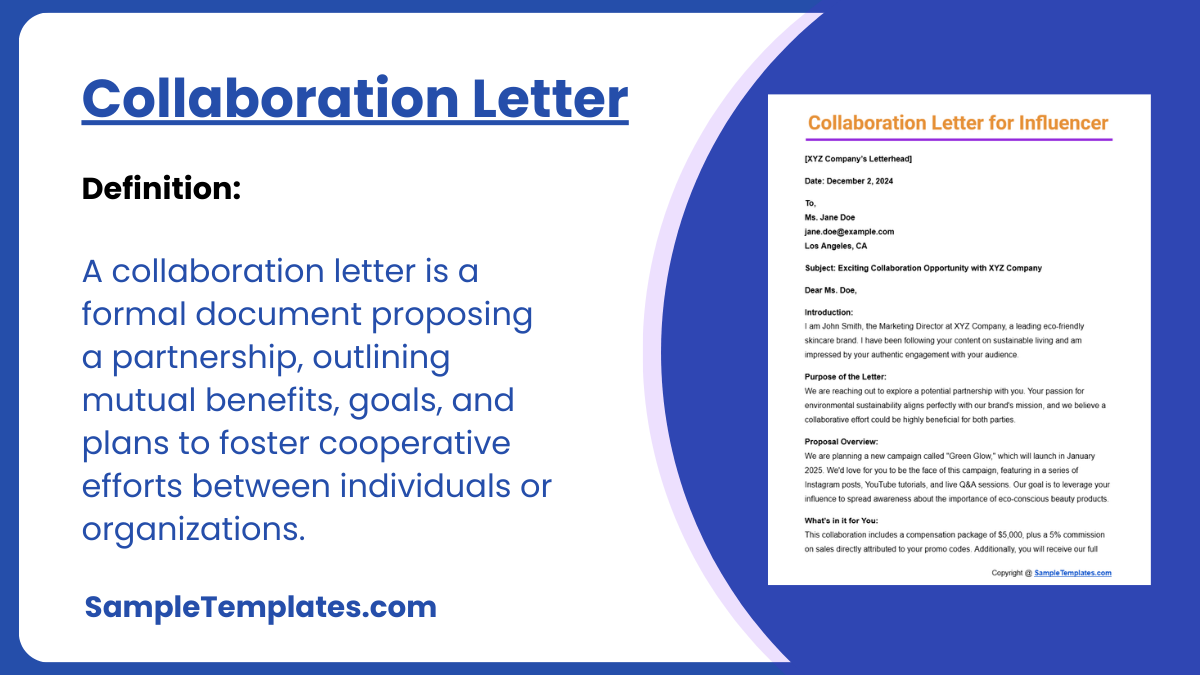Discover the essence of effective partnership with our Sample Collaboration Letter Template. This resource is meticulously designed to assist professionals and organizations in crafting persuasive and clear collaboration requests. Ideal for both US-based and global audiences, it simplifies the process of articulating your collaborative vision, ensuring that your message resonates with potential partners. Whether you’re seeking to establish new business relationships or strengthen existing ones, this template is your essential guide to professional networking success. With its user-friendly format and strategic content, it empowers you to create impactful and meaningful collaboration proposals.
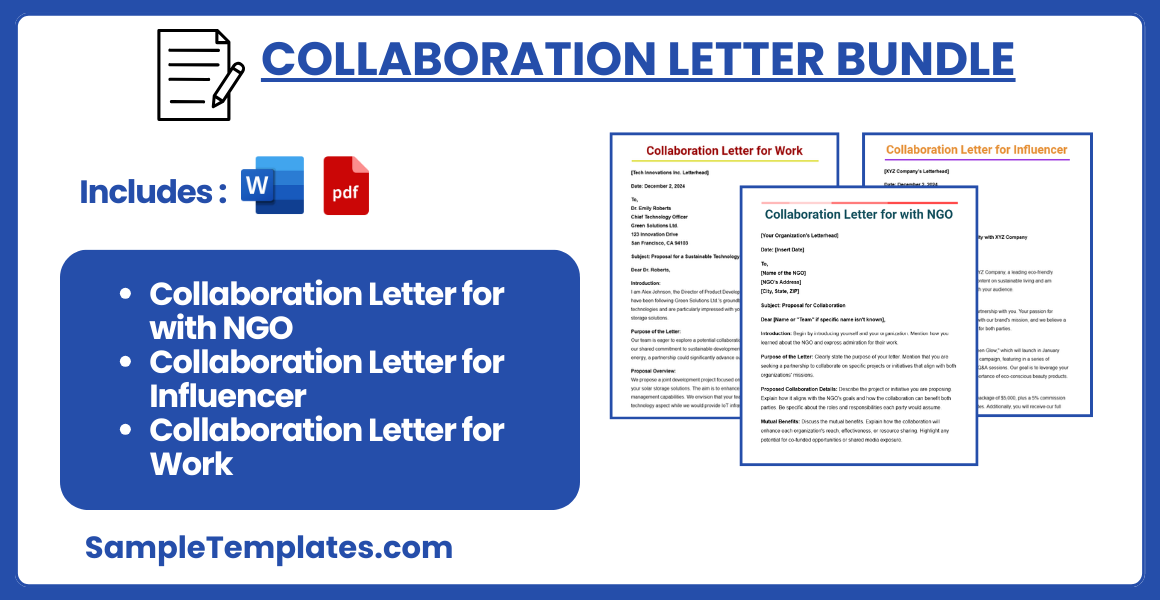
Download Collaboration Letter Bundle
Collaboration Letter for NGO
[Your Organization’s Letterhead]
Date: [Insert Date]
To,
[Name of the NGO]
[NGO’s Address]
[City, State, ZIP]
Subject: Proposal for Collaboration
Dear [Name or “Team” if specific name isn’t known],
Introduction: Begin by introducing yourself and your organization. Mention how you learned about the NGO and express admiration for their work.
Purpose of the Letter: Clearly state the purpose of your letter. Mention that you are seeking a partnership to collaborate on specific projects or initiatives that align with both organizations’ missions.
Proposed Collaboration Details: Describe the project or initiative you are proposing. Explain how it aligns with the NGO’s goals and how the collaboration can benefit both parties. Be specific about the roles and responsibilities each party would assume.
Mutual Benefits: Discuss the mutual benefits. Explain how the collaboration will enhance each organization’s reach, effectiveness, or resource sharing. Highlight any potential for co-funded opportunities or shared media exposure.
Invitation to Discuss Further: Invite the NGO to a meeting to discuss the proposal in more detail. Provide your contact information and suggest a time frame for a meeting or call.
Closing Remarks: Express gratitude for considering your proposal. Reiterate your enthusiasm about the potential for working together and the positive impact the collaboration could have.
Sincerely,
[Your Name]
[Your Position]
[Your Contact Information]
[Organization’s Website] (optional)
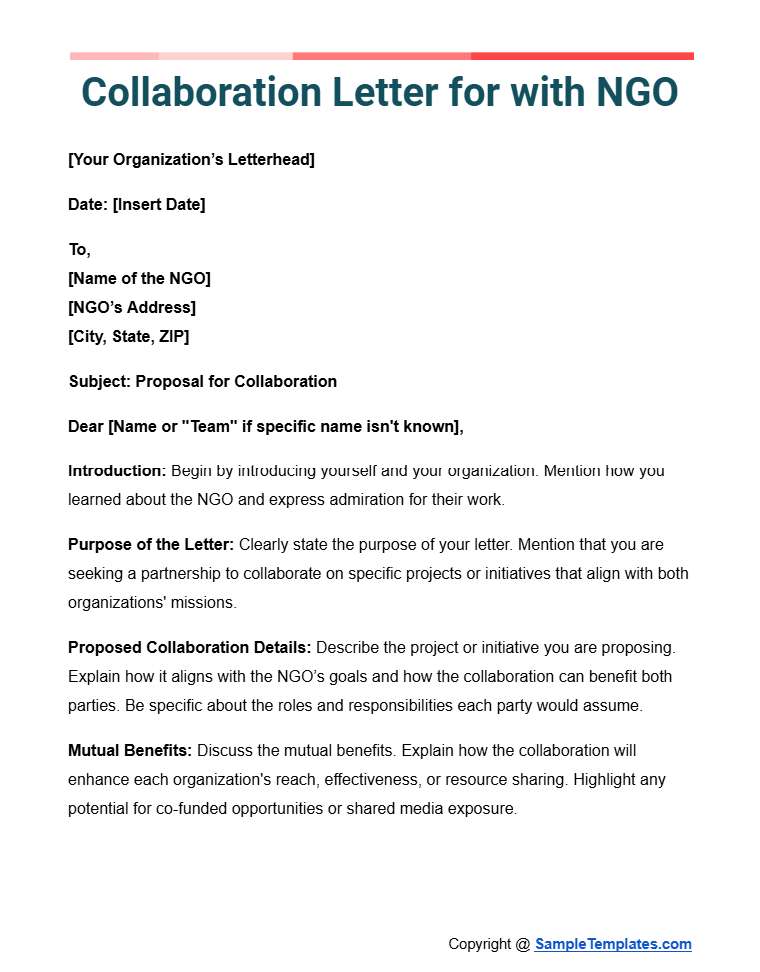
Collaboration Letter for Influencer
[XYZ Company’s Letterhead]
Date: December 2, 2024
To,
Ms. Jane Doe
jane.doe@example.com
Los Angeles, CA
Subject: Exciting Collaboration Opportunity with XYZ Company
Dear Ms. Doe,
Introduction:
I am John Smith, the Marketing Director at XYZ Company, a leading eco-friendly skincare brand. I have been following your content on sustainable living and am impressed by your authentic engagement with your audience.
Purpose of the Letter:
We are reaching out to explore a potential partnership with you. Your passion for environmental sustainability aligns perfectly with our brand’s mission, and we believe a collaborative effort could be highly beneficial for both parties.
Proposal Overview:
We are planning a new campaign called “Green Glow,” which will launch in January 2025. We’d love for you to be the face of this campaign, featuring in a series of Instagram posts, YouTube tutorials, and live Q&A sessions. Our goal is to leverage your influence to spread awareness about the importance of eco-conscious beauty products.
What’s in it for You:
This collaboration includes a compensation package of $5,000, plus a 5% commission on sales directly attributed to your promo codes. Additionally, you will receive our full range of products, and we will also promote your profile across our platforms, boosting your exposure to our substantial audience.
Call to Action:
Please let us know if you would be interested in this opportunity. We would be delighted to set up a call next week to discuss this further and hear any ideas you might have.
Closing Remarks:
Thank you for considering this collaboration. We are excited about the possibility of partnering with you and believe together we can make a significant impact.
Sincerely,
John Smith
Marketing Director
XYZ Company
Contact: john.smith@xyzcompany.com
Website: www.xyzcompany.com
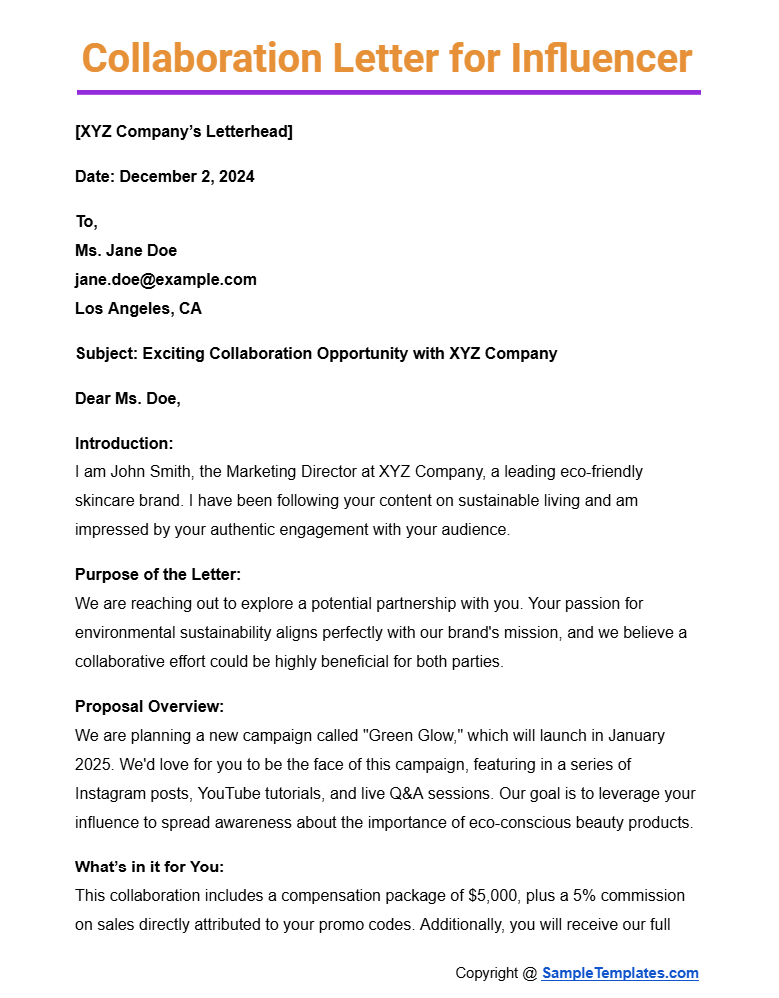
Collaboration Letter for Work
[Tech Innovations Inc. Letterhead]
Date: December 2, 2024
To,
Dr. Emily Roberts
Chief Technology Officer
Green Solutions Ltd.
123 Innovation Drive
San Francisco, CA 94103
Subject: Proposal for a Sustainable Technology Collaboration
Dear Dr. Roberts,
Introduction:
I am Alex Johnson, the Director of Product Development at Tech Innovations Inc. We have been following Green Solutions Ltd.’s groundbreaking work in renewable energy technologies and are particularly impressed with your recent project on solar power storage solutions.
Purpose of the Letter:
Our team is eager to explore a potential collaboration with Green Solutions Ltd. Given our shared commitment to sustainable development and your expertise in renewable energy, a partnership could significantly advance our goals.
Proposal Overview:
We propose a joint development project focused on integrating IoT technologies with your solar storage solutions. The aim is to enhance energy efficiency and remote management capabilities. We envision that your team would lead the renewable technology aspect while we would provide IoT infrastructure and support.
What’s in it for Both Parties:
This collaboration offers Green Solutions access to cutting-edge IoT technology and a broader market reach through our established networks. For Tech Innovations, partnering with a leader in renewable energy would enhance our product offerings and help us achieve our sustainability goals. Together, we can lead the market in smart renewable solutions.
Call to Action:
We would greatly appreciate the opportunity to discuss this proposal in more detail. Could we arrange a meeting or a conference call during the week of December 15th to further explore how we can make this partnership successful?
Closing Remarks:
Thank you for considering this opportunity for collaboration. We are excited about the potential to combine our strengths and lead innovation in sustainable technologies.
Sincerely,
Alex Johnson
Director of Product Development
Tech Innovations Inc.
Contact: alex.johnson@techinnovations.com
Website: www.techinnovations.com
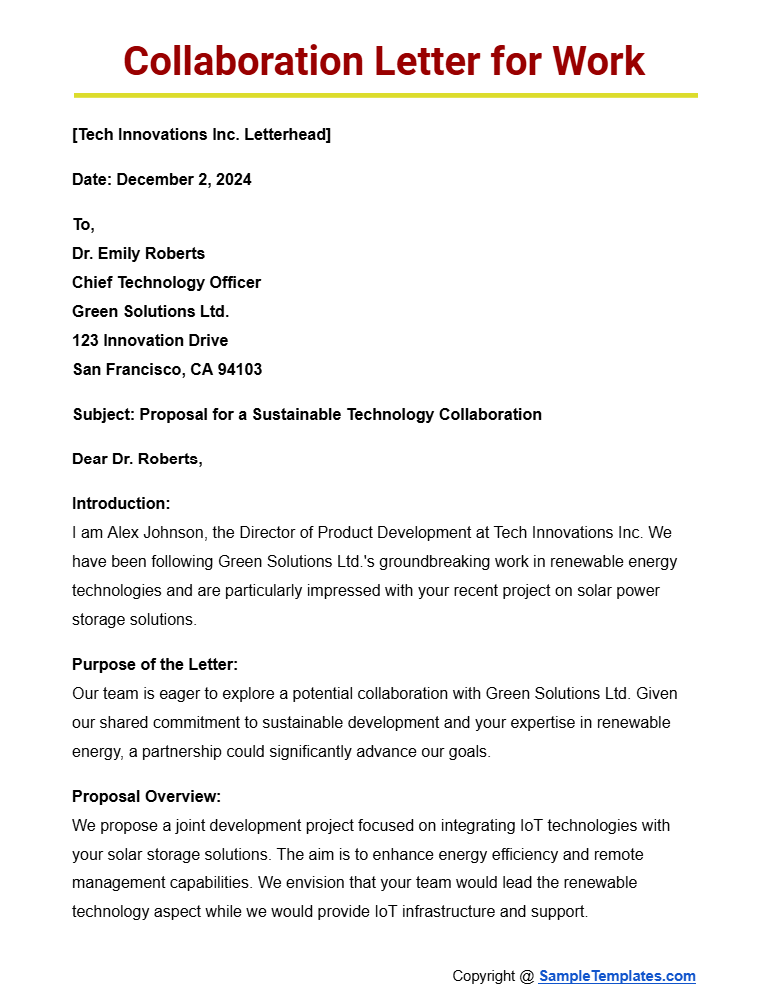
Browse More Templates On Collaboration Letter
1. Sample Collaboration Letter Template
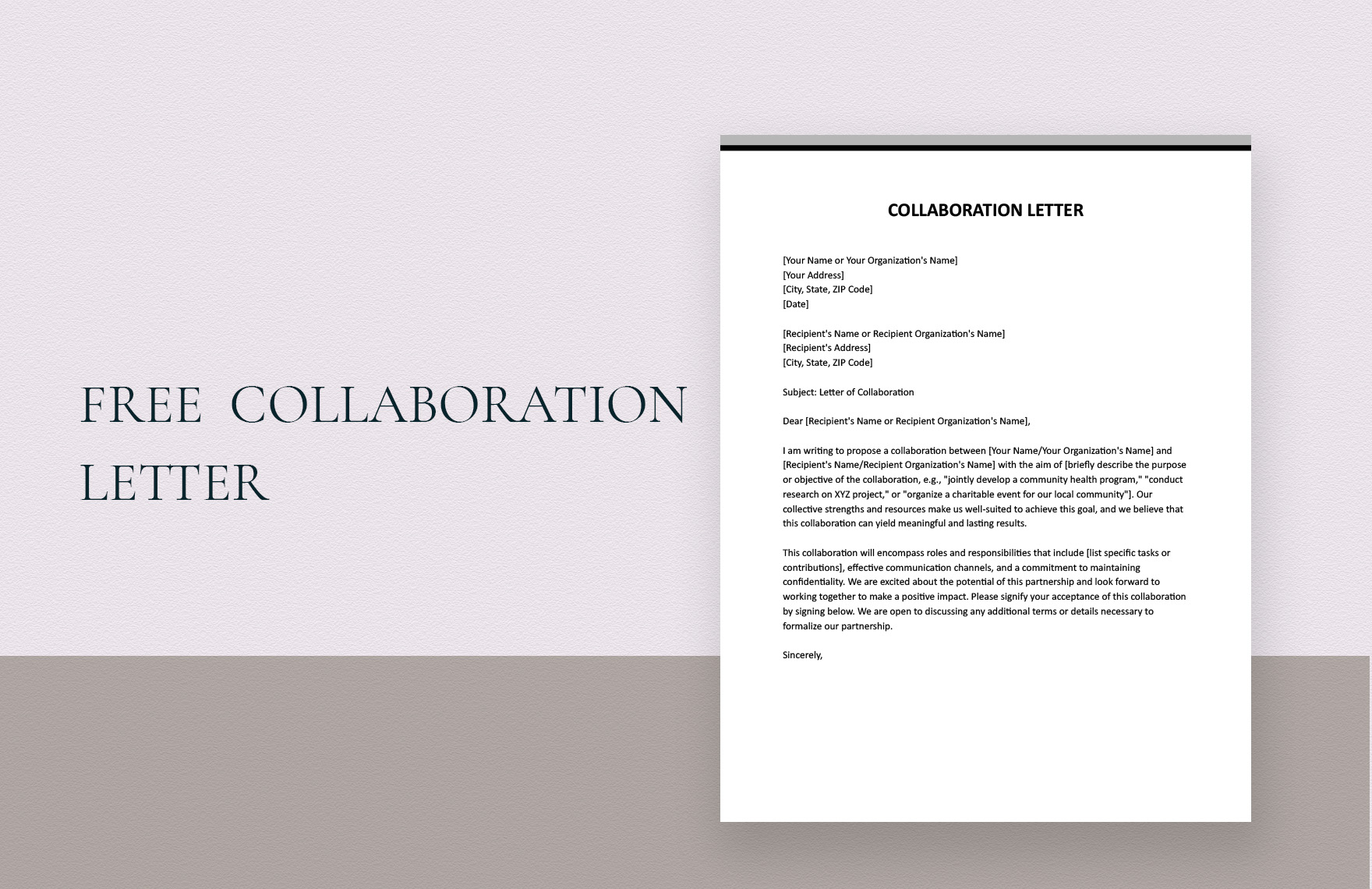
2. Sample Research Collaboration Letter
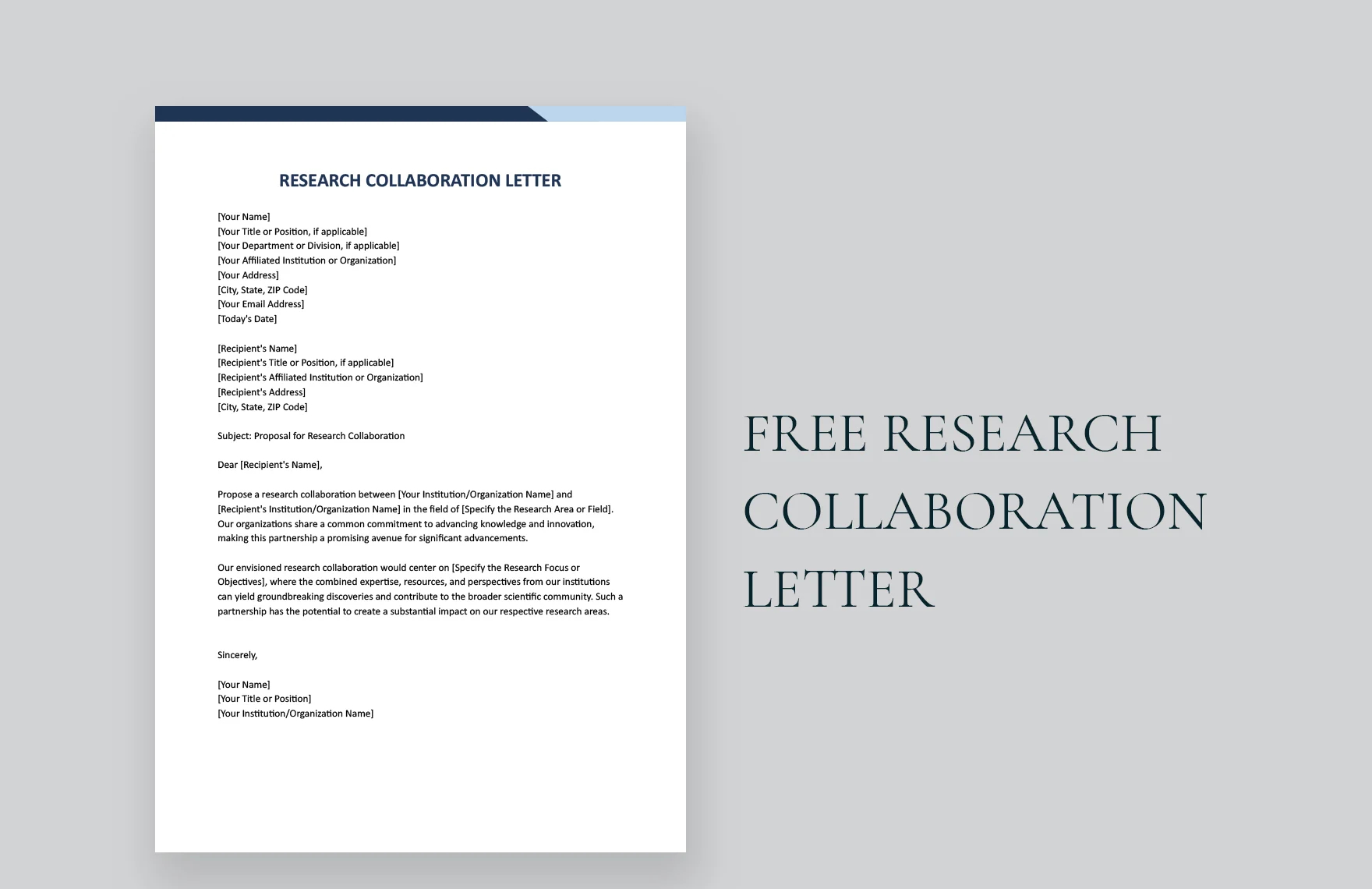
3. Business Collaboration Letter Template
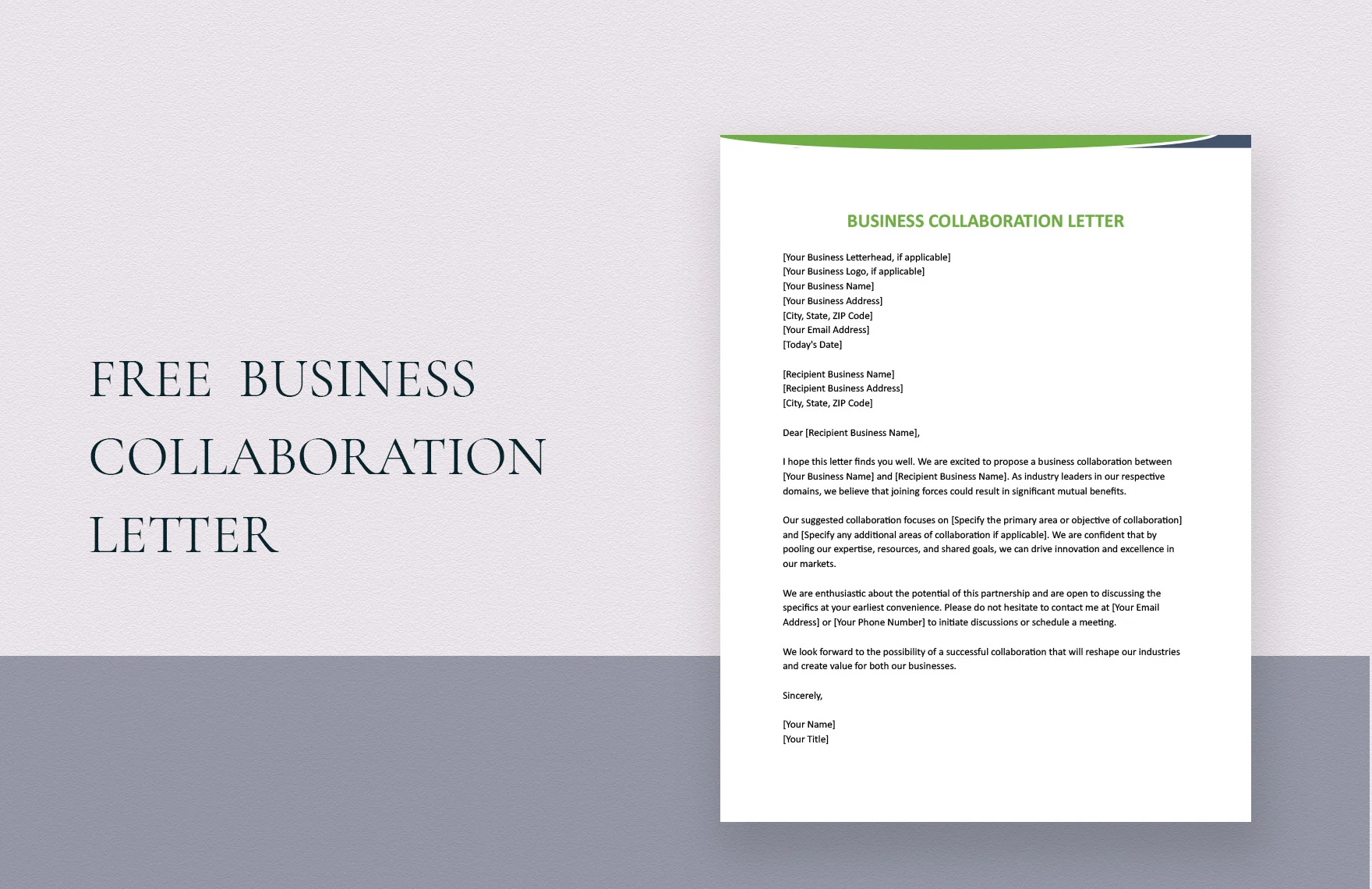
How Do You Write a Letter for Collaboration?
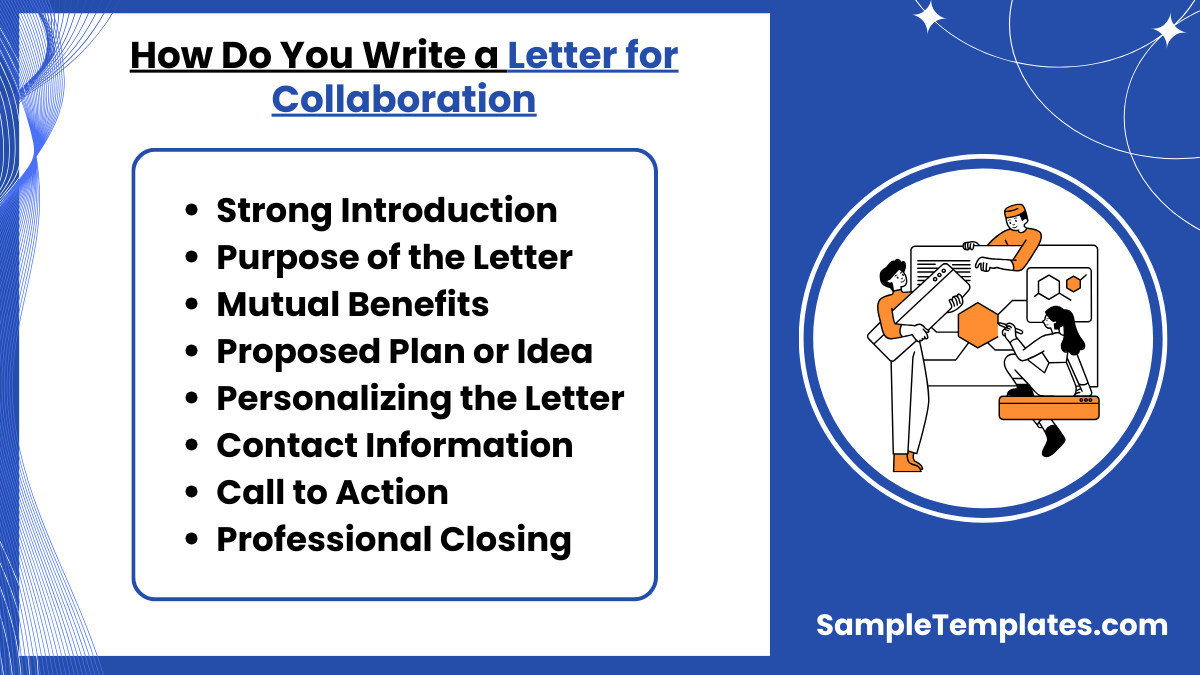
Writing a letter for collaboration is a strategic approach to forming or enhancing professional relationships. It requires clarity, persuasion, and a clear understanding of the mutual benefits. Here’s how you can write an effective collaboration letter:
1. Strong Introduction
Start by introducing yourself or your organization with a compelling opening line. This is your first impression, so make it count. Share a brief, engaging story or an impressive statistic related to your work. Highlight your unique position in your industry or your innovative approach to business. This introduction should not only present who you are but also hint at the value you bring to a potential collaboration.
2. Purpose of the Letter
After your introduction, transition smoothly into the purpose of your letter. Be direct but engaging. Instead of simply stating you wish to collaborate, weave in your motivation for choosing this specific individual or organization. Perhaps their values align with yours, or their recent project sparked your interest. This section should clearly establish not just the ‘what’ but the ‘why’ of your proposal.
3. Mutual Benefits
This is where you delve into the details of what both parties stand to gain from this partnership. Discuss potential outcomes like shared resources, combined expertise, or expanded market presence. Be enthusiastic yet realistic about the prospects of your collaboration. Paint a picture of a mutually beneficial relationship where both parties achieve more together than they could alone.
4. Proposed Plan or Idea
Here, present your vision for the collaboration. This could be a joint venture, a co-sponsored event, a shared marketing campaign, or a research project. Provide enough detail to make your proposal tangible but remain open to their ideas and inputs. This is not just about pitching your plan; it’s about starting a conversation.
5. Personalizing the Letter
Customization is key in this section. Reference specific aspects of their work that impress you or align with your goals. Mention any personal interactions you may have had, such as a meeting at a conference or a webinar they hosted that you attended. This personal touch can make your letter stand out.
6. Contact Information
Include your contact information, but also suggest the best ways and times to reach you. If you’re often in meetings or unavailable at certain hours, let them know. This attention to detail can make scheduling a follow-up conversation smoother.
7. Call to Action
End with a clear invitation letter for further discussion. Whether it’s a meeting over coffee, a phone call, or a formal presentation of your proposal, suggest a next step. Be enthusiastic but respectful, showing you value their time and input.
8. Professional Closing
A professional closing reassures the recipient of your professionalism and respect. After signing off, consider including a postscript (P.S.) with a final intriguing fact or statement to leave a lasting impression.
Additional Tips:
- Adapt to the Recipient: If your recipient is known for a particular business style or communication preference, tailor your letter to match.
- Be Authentic: While professionalism is key, don’t shy away from showing genuine enthusiasm and personality.
- Cultural Sensitivity: If writing to someone from a different cultural background, be mindful of cultural nuances in business communication.
Remember, a collaboration letter is more than just a formality; it’s an opportunity to start a potentially valuable partnership. By clearly communicating your intentions and showing respect for the recipient’s time and achievements, you set the foundation for a successful collaboration.
4. Sample Request for Collaboration Letter
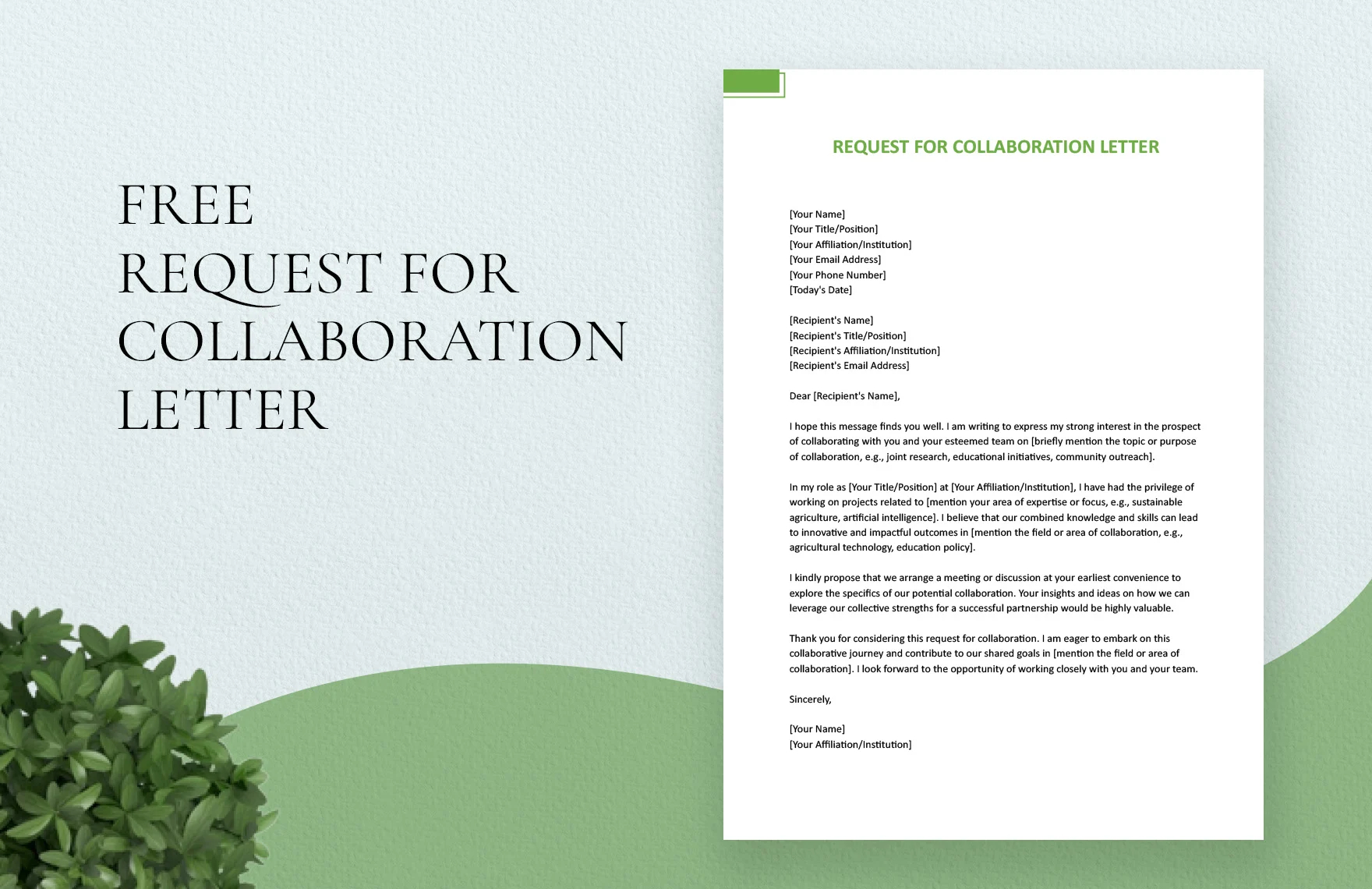
5. Proposal Collaboration Letter Template
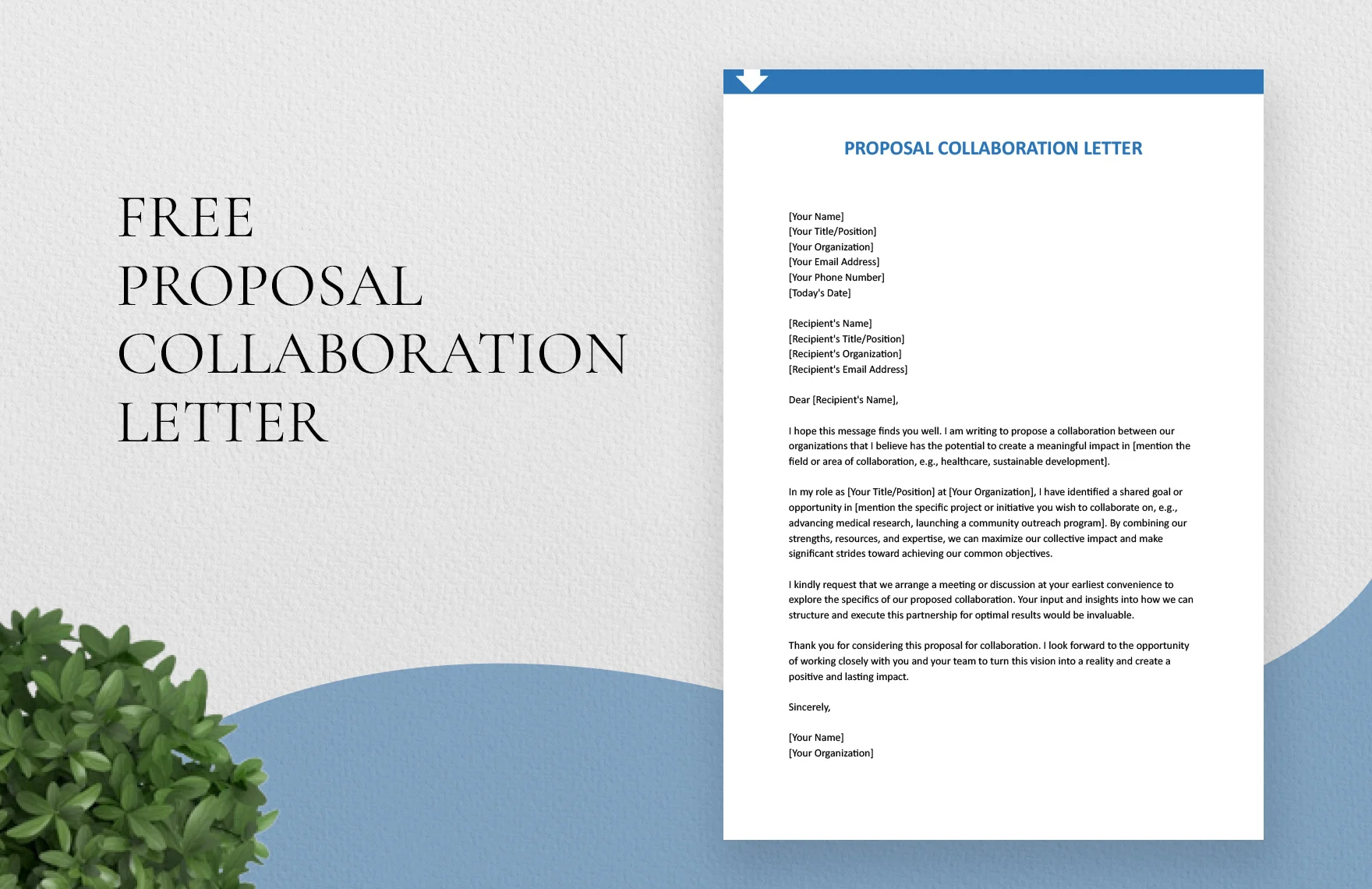
6. Sample Company Collaboration Letter Template

7. Sample Letter of Collaboration Template
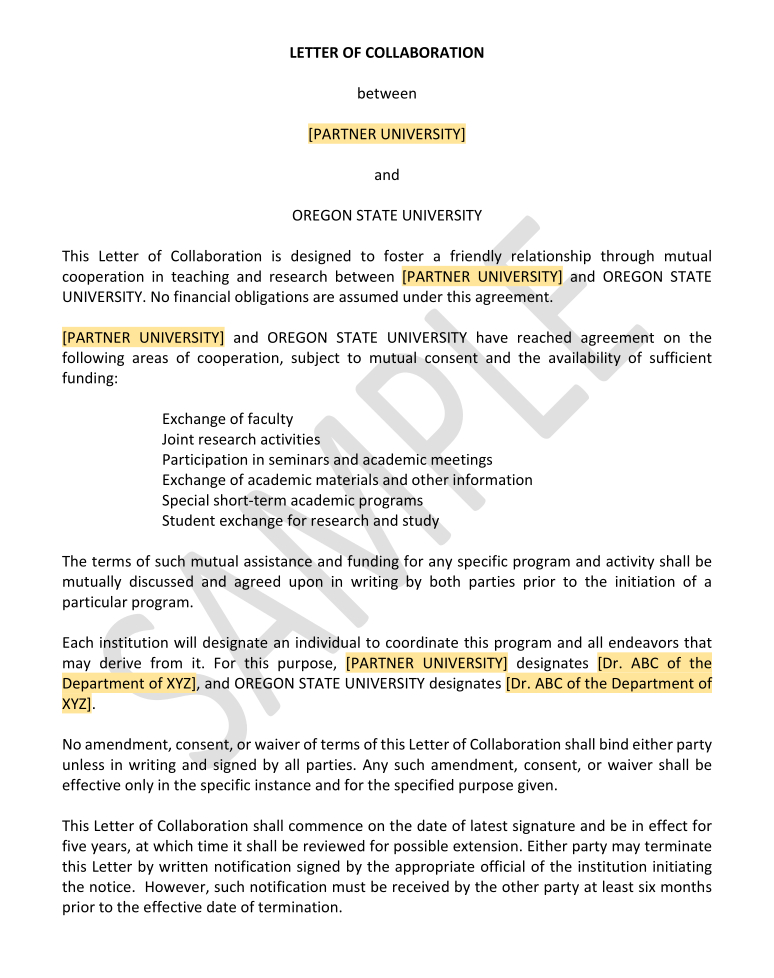
Who Needs a Collaboration Letter ?
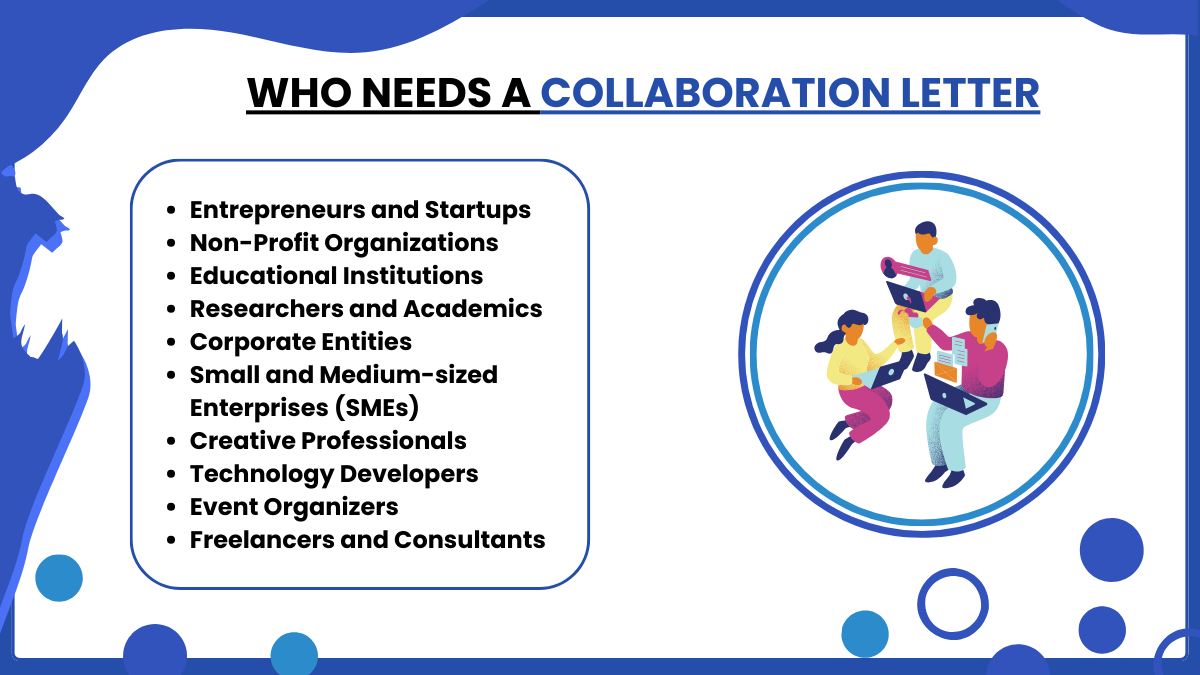
A collaboration letter sample is a versatile tool that serves various professionals and organizations across multiple sectors. This type of letter is essential for anyone looking to establish or strengthen partnerships, explore new opportunities, or expand their professional network. Here’s a detailed look at who might need a collaboration letter sample:
1. Entrepreneurs and Startups
For entrepreneurs and startups, collaboration is key to growth and innovation. A sample collaboration letter can help these individuals and companies to reach out to potential partners, investors, or mentors. It provides a structured way to present their ideas and propose partnerships that could lead to shared resources, knowledge exchange, and expanded market reach.
2. Non-Profit Organizations
Non-profits often rely on collaborations for funding, program implementation, and advocacy efforts. A well-crafted collaboration letter can aid them in approaching potential donors, partnering with other non-profits for joint ventures, or engaging with government agencies for support and endorsements.
3. Educational Institutions
Schools, colleges, and universities can use collaboration letters to establish ties with other educational institutions, industry partners, and research organizations. These partnerships can facilitate student exchanges, collaborative research projects, and joint educational programs.
4. Researchers and Academics
Individual researchers and academics need collaboration to advance their studies, share knowledge, and gain access to resources. A collaboration letter can be instrumental in initiating joint research projects, sharing academic findings, or securing funding from institutions and private sponsors.
5. Corporate Entities
Large corporations often seek collaborations for various reasons, including expanding into new markets, enhancing their product offerings, or participating in corporate social responsibility (CSR) initiatives. A sample letter can guide them in approaching potential partners, aligning their goals, and formalizing agreements.
6. Small and Medium-sized Enterprises (SMEs)
SMEs can benefit significantly from collaborations, especially when exploring new business opportunities or trying to scale operations. A collaboration letter can help these businesses connect with larger companies, form strategic alliances, or engage in B2B partnerships.
7. Creative Professionals
Artists, musicians, writers, and other creatives often collaborate to enhance their exposure and create joint works. A collaboration letter can assist in proposing joint exhibitions, co-authoring projects, or collective performances.
8. Technology Developers
In the fast-paced tech industry, collaboration is crucial for innovation and development. Tech companies and individual developers can use these letters to propose joint development projects, share technological expertise, or engage in co-marketing efforts with other tech firms.
9. Event Organizers
For those planning events, from conferences to cultural festivals, collaborations can provide essential support and resources. A collaboration letter can help in securing sponsors, partners, or speakers, ensuring the event’s success.
10. Freelancers and Consultants
Freelancers and consultants often need to collaborate with other professionals to expand their service offerings and cater to a broader client base. A collaboration letter can be crucial for forming alliances and building a professional network.
In summary, a collaboration letter sample is a crucial asset for a wide range of professionals and organizations. It facilitates the initiation of partnerships, enhances opportunities for growth, and fosters a culture of cooperative effort across various industries and sectors.
8. Recommended Letter of Collaboration Template

9. Formal Collaboration Letter Template

What are the Essential Factors to Writing Collaboration Letters?
Writing collaboration letters is an art that combines diplomacy, clarity, and persuasion. These letters are crucial for initiating partnerships, proposing joint ventures, or extending professional networks. To craft an effective collaboration letter, several essential factors must be considered:
Clarity of Purpose
The foremost element of a collaboration letter is a clear statement of purpose. The letter should succinctly outline why you are reaching out and what you hope to achieve through the collaboration. Avoid ambiguity; your intentions should be transparent to encourage a positive response.
Understanding of the Recipient
A successful collaboration letter is tailored to its recipient. Demonstrate your understanding of their business, achievements, or expertise. This shows respect and genuine interest, which can be a decisive factor in their willingness to collaborate.
Articulation of Mutual Benefits
One of the most persuasive aspects of a collaboration letter is the emphasis on mutual benefits. Highlight how the collaboration will be advantageous for both parties involved. This could include shared resources, combined expertise, market expansion, or enhanced credibility.
Professional Tone
Maintain a professional tone throughout the letter. It should reflect respect and courtesy, irrespective of the level of familiarity with the recipient. Professionalism in communication lays the foundation for a serious and fruitful partnership.
Specific Proposal or Idea
Go beyond a general request for collaboration; present a specific idea or proposal. This could be a project, event, or joint initiative. Providing a concrete idea gives the recipient something tangible to consider and respond to.
Personalization and Engagement
Personalize your letter by referencing the recipient’s recent work, achievements, or specific areas of expertise. This personal touch can create a connection and make your letter stand out. It also shows that you have done your research and are not sending generic requests.
Clear Call to Action
End your letter with a clear call to action. Invite the recipient to respond, suggest a meeting, or propose a phone call to discuss further. This prompts the recipient to take the next step and shows your eagerness to move forward.
Follow-Up Strategy
Plan for a follow-up if you don’t receive a response within a reasonable timeframe. A polite reminder or a follow-up email can demonstrate your commitment and interest in the collaboration.
Professional Closing
Conclude your letter with a professional closing, like “Sincerely” or “Best Regards,” followed by your name and title. This reinforces the professional nature of your correspondence.
Proofreading and Refinement
Finally, proofread your letter thoroughly to ensure it is free of errors. A well-written, error-free letter reflects your professionalism and attention to detail.
Incorporating these essential factors will significantly enhance the quality and effectiveness of your collaboration letters. They not only convey your proposal clearly but also demonstrate your professionalism, respect for the recipient, and sincere interest in establishing a mutually beneficial partnership.
10. Letter of Collaboration Request Form Sample
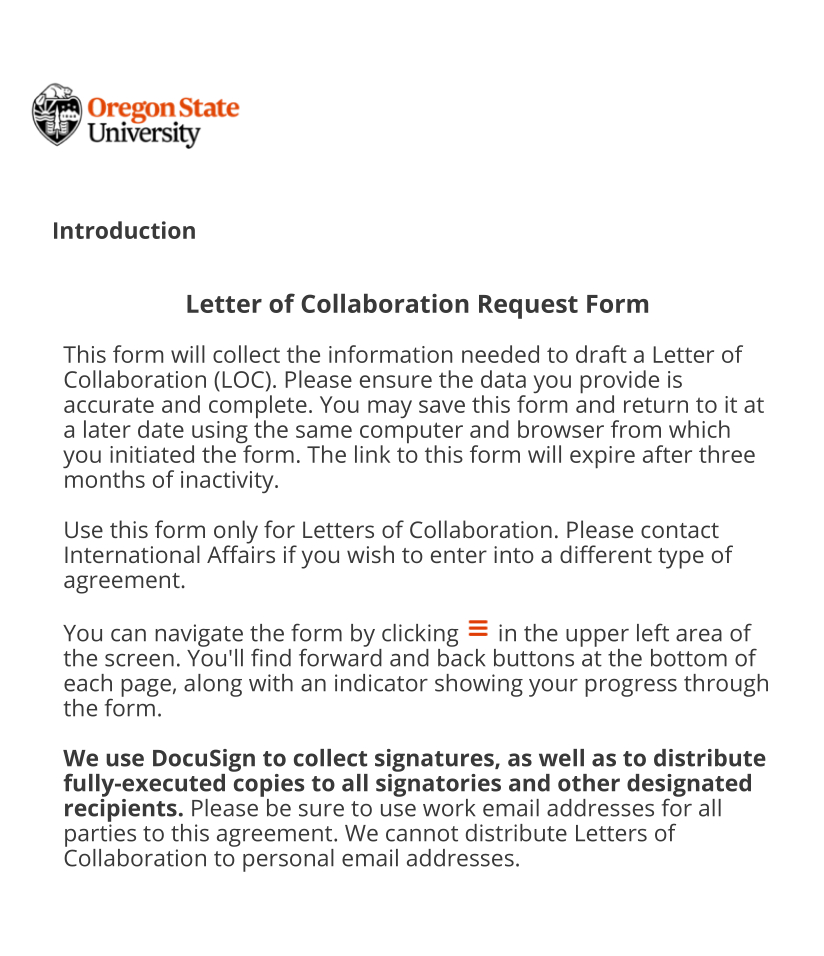
11. Template for Letter of Collaboration

What is a Collaboration Letter?
A collaboration letter is a formal document sent by an individual or organization to propose a partnership or joint venture with another party. It outlines the intent to collaborate, details of the proposed partnership, and the mutual benefits involved.
Why is a Collaboration Letter Important?
It’s a professional approach to proposing a partnership. It helps to formally introduce your ideas and intentions to a potential collaborator, and it sets the tone for future interactions.
Who Typically Sends Collaboration Letters?
Entrepreneurs, businesses, non-profit organizations, researchers, educational institutions, and even individuals seeking to establish or enhance partnerships and working relationships send collaboration letters.
What Should Be Included in a Collaboration Letter?
A collaboration letter should include a clear introduction, the purpose of the letter, details of the proposed collaboration, the benefits for both parties, a call to action, and your contact information.
How Do I Start a Collaboration Letter?
Start with a brief introduction of yourself or your organization, followed by a statement of purpose that explains why you are writing the letter.
Is It Necessary to Personalize Each Collaboration Letter?
Yes, personalizing your letter shows that you have done your research and are genuinely interested in collaborating with the specific individual or organization.
Collaboration letters are a fundamental tool in the realm of professional communication, playing a pivotal role in initiating and fostering business partnerships and joint ventures. They require a thoughtful blend of clarity, personalization, and professionalism. Whether it’s for a budding entrepreneur, a large corporation, or a non-profit organization, a well-crafted collaboration letter can open doors to new opportunities, mutual growth, and lasting professional relationships. It’s essential to invest time in personalizing each letter, ensuring it resonates with the intended recipient and clearly conveys the potential benefits of the proposed collaboration.
Related Posts
-
10 FREE Retirement Announcement Letter Samples & Templates
-
10 FREE Employee Recognition Letter Samples & Templates
-
12 FREE Acknowledgement Letter Samples & Templates
-
8 FREE College Rejection Letter Samples & Templates
-
10+ FREE Letters of Reprimand Samples & Templates
-
11+ FREE Cancellation Letter Samples & Templates
-
10 FREE Insurance Cancellation Letter Templates (& Samples)
-
10 FREE Jury Duty Excuse Letter Templates & Samples
-
10+ FREE Goodwill Letter Templates (& Samples)
-
FREE 10+ Joining Letter Samples In MS Word | Google Docs | PDF
-
FREE 6+ Sample Relieving Letter Templates in MS Word | Google Docs | PDF
-
FREE 3+ Construction HR Letter Samples in MS Word | Google Docs | PDF
